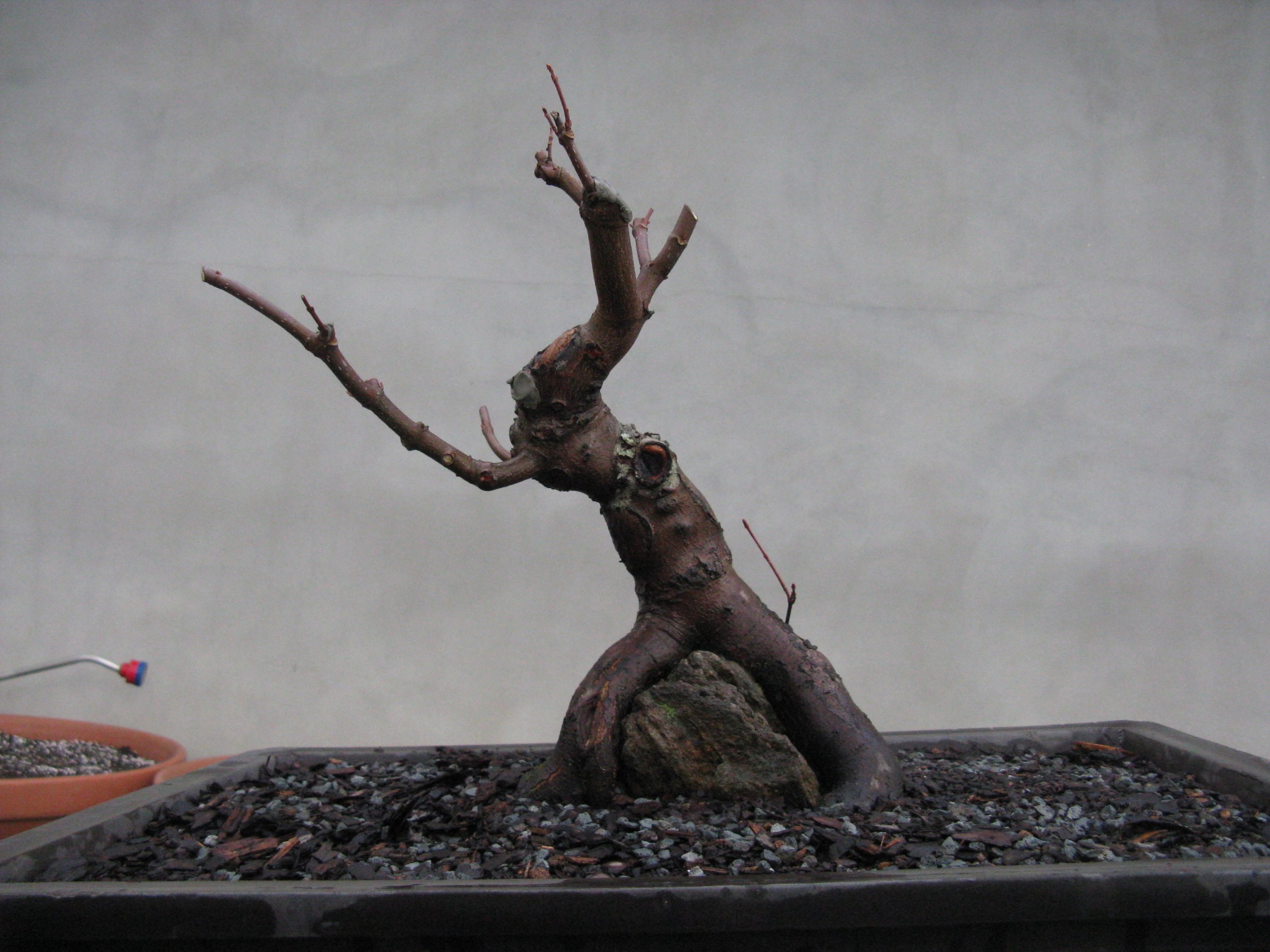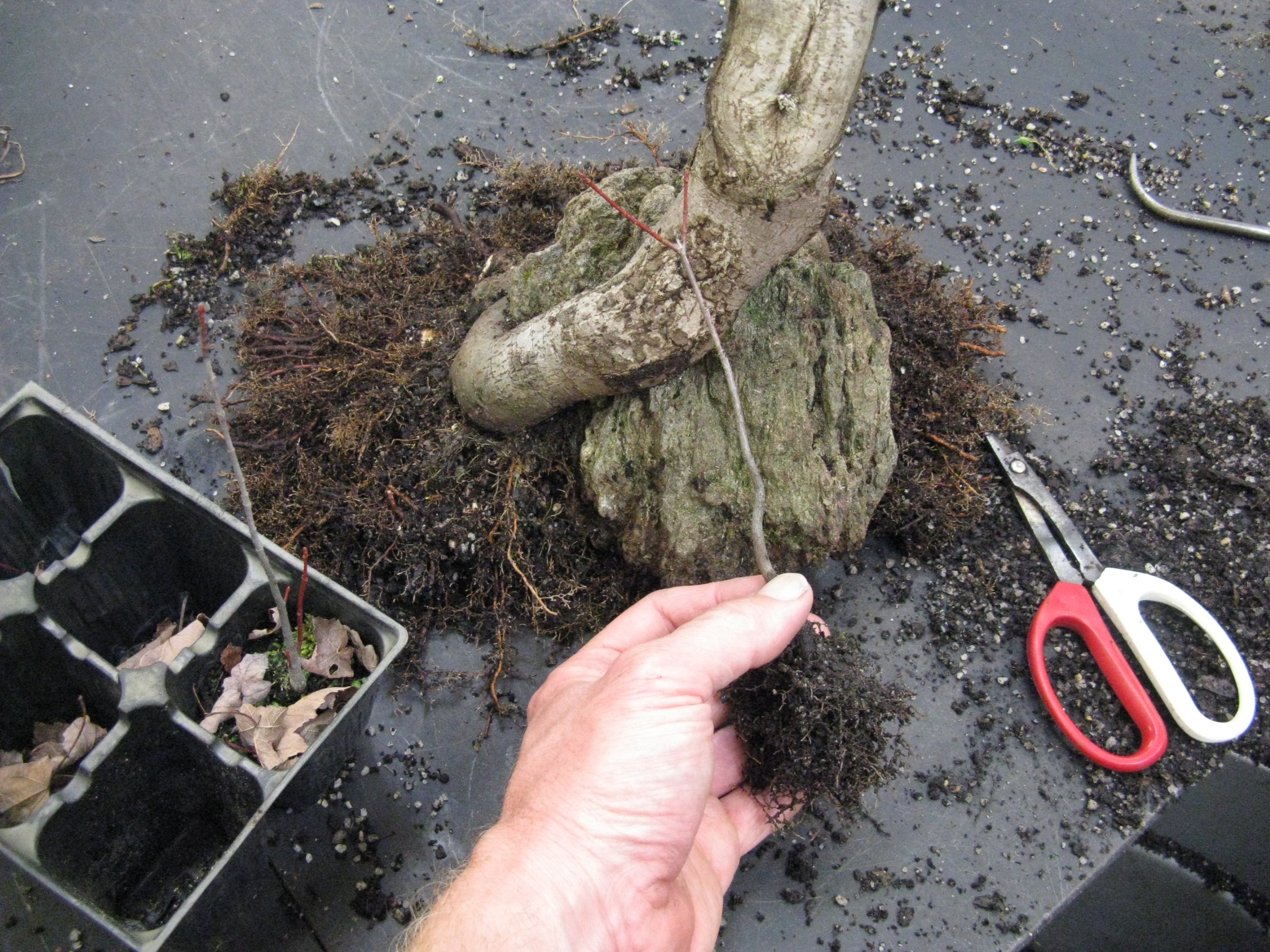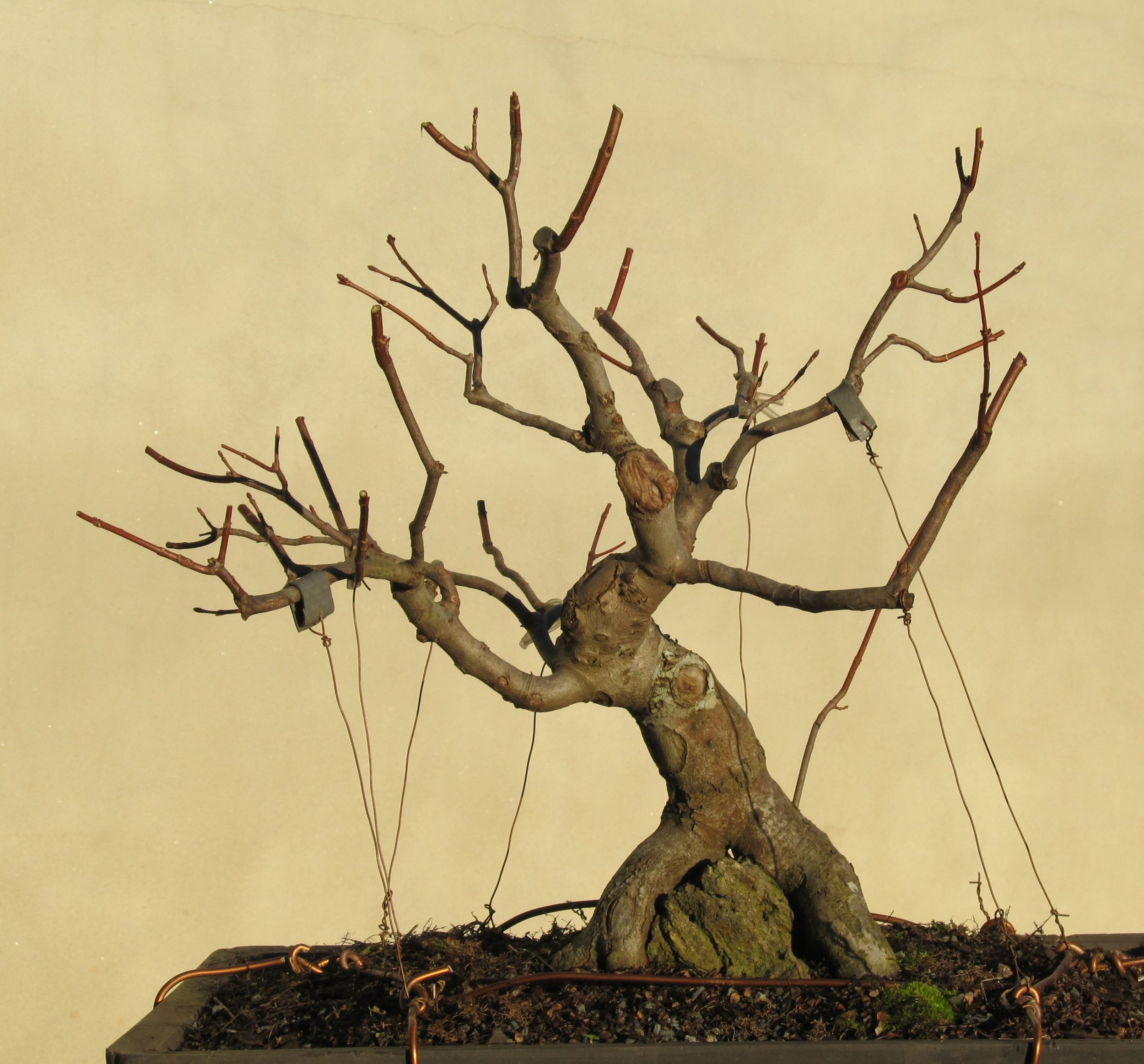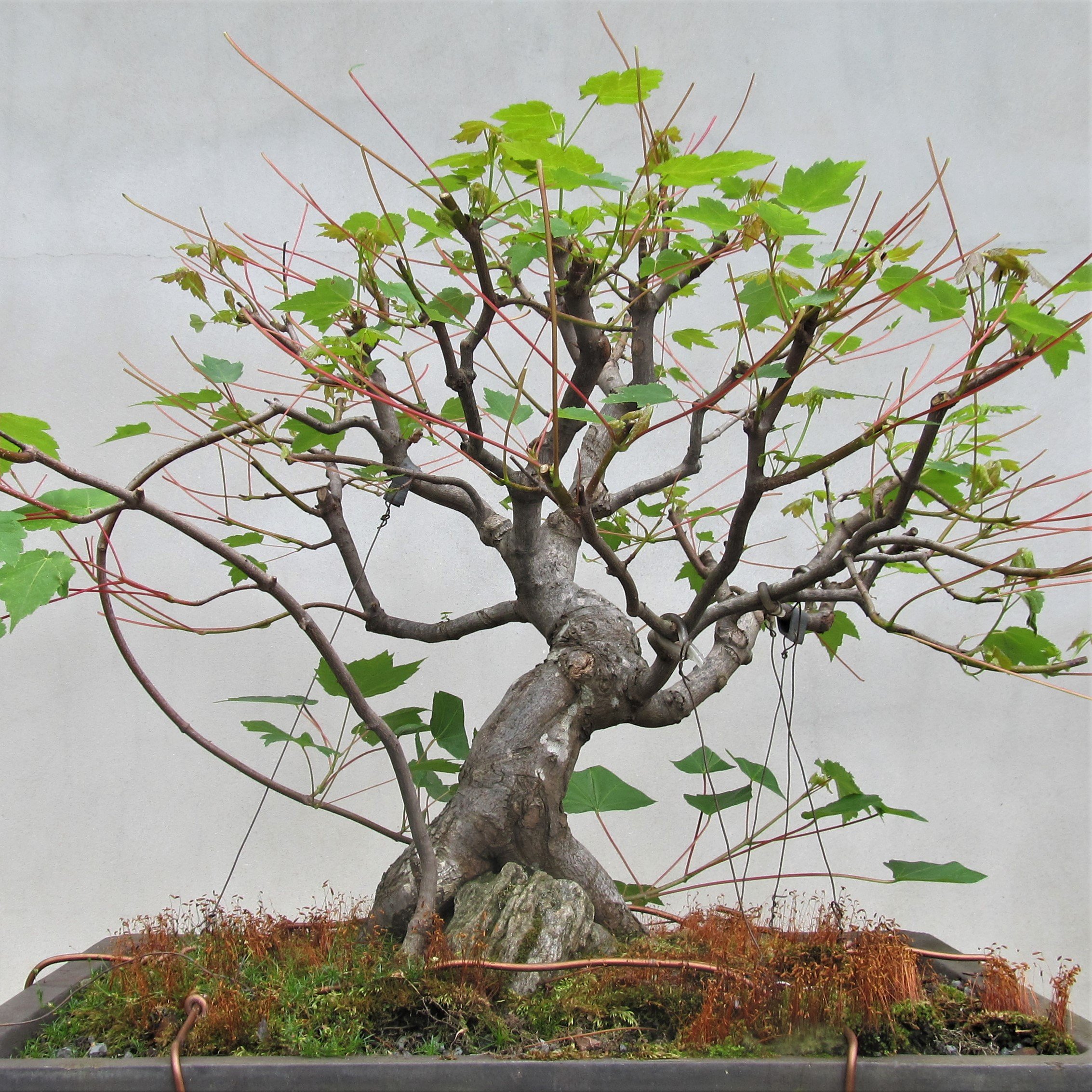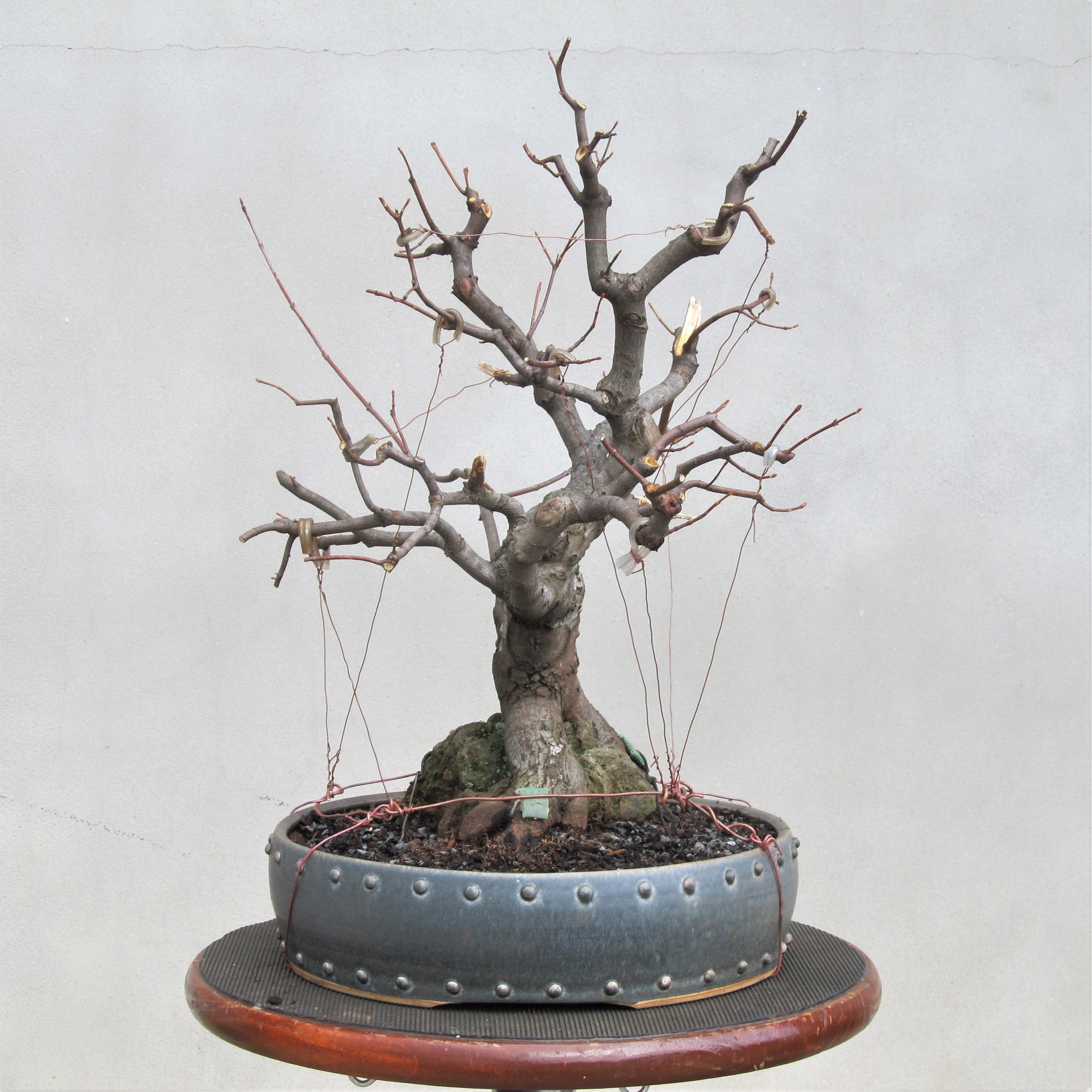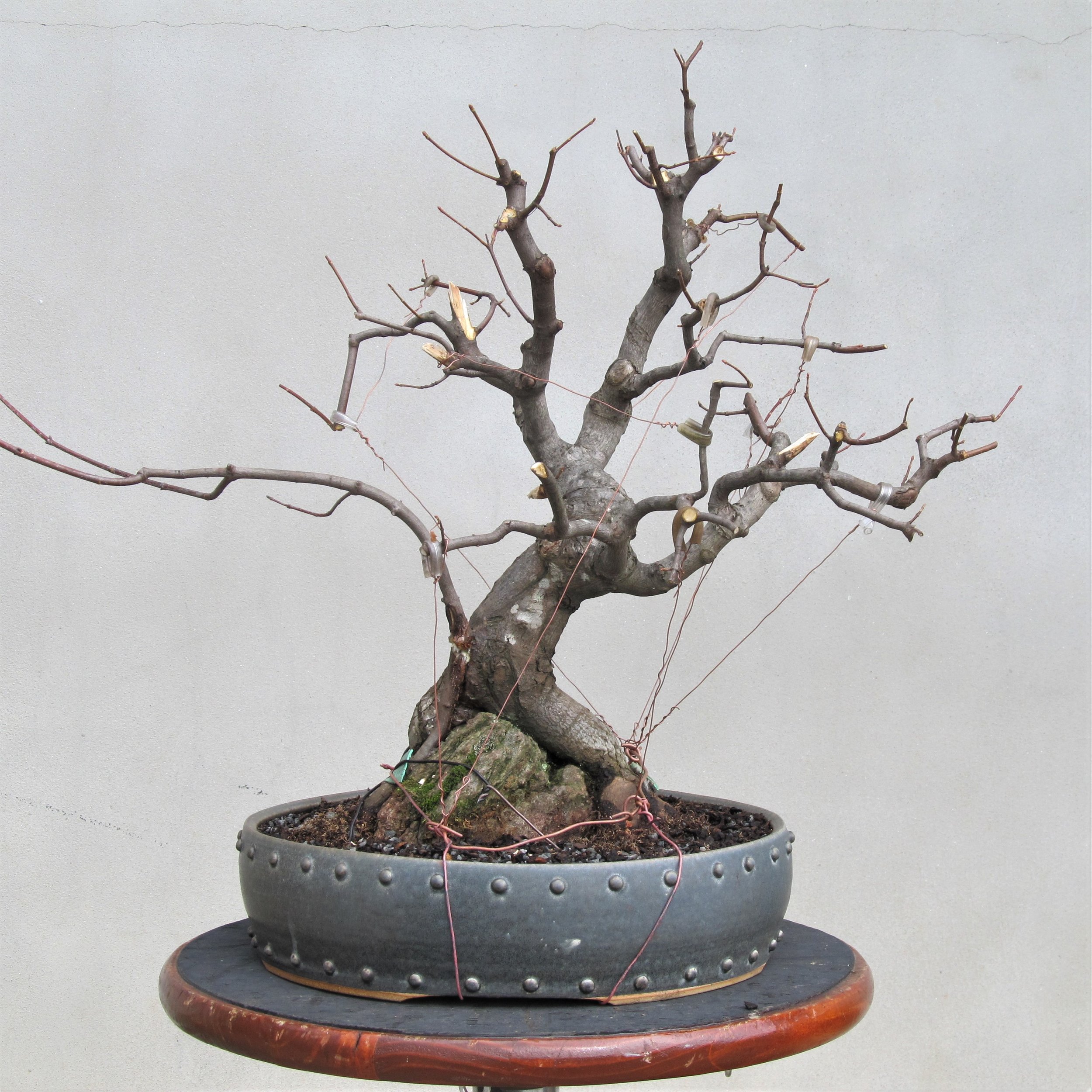The Wounded Rider - Part 1
An acquaintance back in the late 1990s gave me a little red maple (Acer rubrum) in a pint-size pot. It had been grown from a cutting taken from a tree that exhibited outstanding autumn color. Although this very young plant offered absolutely nothing to suggest it would make a good bonsai, I thought I would aim it that way because in those days every plant I came across was a likely candidate for that purpose. The first time I went to transplant it, however, I found the little maple had a problem with its roots. You couldn't say the root system was poor because there was a sufficient amount of rootage present, but the way it was constructed was not good. Just below the soil line the single line of the stem that would ultimately be the tree's trunk bifurcated into two roughly equal primary root lines off of which all the rest of the roots emerged. It looked like this:
Such a construction would pose no obstacle to this young plant developing into a perfectly fine landscape tree. As a potential bonsai, though, the way the roots were arrayed would almost certainly lead to an unacceptable base on the mature tree. A bonsai ideally has a spreading base featuring visible surface roots radiating outward in multiple directions, as seen in this example:
It is not possible to achieve this desired look when working with only two surface roots, which is all the maple in question would likely have when it grew up. This structural shortcoming is something you learn to recognize when evaluating plant material for bonsai use. After a while you also learn to save yourself frustration by not choosing to use plants that have obvious flaws. At the time when I started working with this maple I had already learned enough to recognize the problem inherent in its rootage, but I hadn't yet learned the value of being more choosy. Instead, I decided to try using the unpromising baby tree to make a root-over-rock bonsai. I had been reading about how to do that.
The process I followed involved finding an appropriate sized, visually interesting stone and draping the young roots over it, binding them in place with twine. Then the tree and stone were planted together in the ground. The stone was actually submerged in the earth while the roots of the maple were allowed to grow around it. After several years, when the visible part of the planting had attained a little size, the tree and stone were dug up. They were then transplanted together into a large wooden grow box, but this time situated in a higher position so the rock and the roots draped over it were exposed. By the time this part of the procedure is done the primary roots should have begun to enlarge and lignify. The desired effect is to have the roots conform to the contours of the rock so it looks as if they are clasping it.
This little experiment went well. Unfortunately, the whole business was undermined by the root problem that was there from the start. I thought being planted on the rock would mitigate the effect of the two-way rootage, but it did not. The tree still had only two surface roots. But now, instead of those roots being briefly visible before disappearing below the surface of the potting medium, they were fully displayed draped over a rock.
The little maple growing on the rock kicked around the nursery for many years, growing more stout all the while. Any time I looked at it the sight of the ungainly pair of roots deterred me from investing much time in developing the piece. One day, however, I decided to try and do something about the problem. The maple was finally photographed for the first time in November of 2009, on the occasion of the work session when this effort was made:
The strategy was to add a third root line to the existing two. This was to be accomplished by planting a young red maple seedling at the base of the rock, laying its stem alongside the rock and then grafting the upper part of the seedling to the base of the bigger tree. These two images illustrate how this was done (click on either image for full view):
A thin channel was cut into the base of the bigger tree and then the stem of the seedling was laid into it, held in place by a staple and then sealed with grafting wax.
The next available image comes from November of the following year:
At this point, new growth that had developed over the course of the growing season was trimmed and then shaped with wire.
The following pictures show the maple before and after a winter work session in 2013 (click on either image for full view):
As can be seen in the above images, the seedling tree was still in place and doing well. It did not get trimmed back because the desire was to have the stem of it enlarge as quickly as possible, and unrestrained growth is the most likely means to accomplish that objective. Note, as well, the use of guy wires to pull branches into position. This method of training poses less risk of scarring branches than when they are fully wrapped in wire.
In 2014 it seemed the seedling had successfully grafted to the trunk of the larger tree. The next step was to cut off the upper section of the seedling, leaving only the graft union and everything below it, with the intention of creating a third root line made out of what had been the lower trunk of the seedling. The roots of the seedling would still be stretched out in the growing medium, drawing up moisture and nutrients, sending those goods up the trunk. But now, instead of communicating with the top of the seedling (no longer existing), the water and nutrients would be directed to the body of the larger tree. The tree bearing the newly grafted part would in turn send back a portion of the sugars produced by photosynthetic activity, to keep the new part alive and growing.
That's how it's supposed to work, but in this case it didn't. Perhaps I cut off the upper section of the seedling prematurely, or maybe the graft union was poor. Whatever the reason, the lower section of the seedling withered and died and my grafting attempt was a failure. I didn't choose to record any of this in photographs.
Later that year, David DeGroot was the guest artist at the 2014 Carolina Bonsai Expo. He had recently retired after an accomplished twenty-year career as curator of the Pacific Rim Bonsai Collection. I had always admired David as a bonsai professional, so after the Expo was over I took the opportunity to walk with him through the Arboretum's collection and talk a little shop. We were out in the hoop house and it happened that he stopped before the red maple on the rock. The side with the scar from the failed graft was not showing and David did not know anything about the tree's history, but he looked at the maple astride the rock and saw two legs. He broke into a big grin and said, "Whoa! Ride 'em cowboy!"
That was a funny comment and I remember the moment fondly. The joke jabbed a little, though — enough to prompt me to try another graft.
In the spring of 2015 I took a larger-sized young red maple and planted it alongside the rock, like I had done on the previous attempt. This time I waited on making the graft, to allow the newly introduced tree a chance to establish itself. The following images show the maple on the rock, with the new tree behind it (click on either image for full view):
Later that same year, after the growing season was over, the red maple received an intensive styling session. The structure of the crown was brought into sharper focus, mostly through pruning but once again with the aid of guy wires. The tree and stone were transplanted to a new container made by Charles Smith of MC2 pottery in Tennessee. And finally, after taking well to its new environs, the young maple was fastened to the older tree by means of an approach graft.
The following gallery gives an in-the-round view of the maple on the rock at the conclusion of the described work (click on any image for larger view):
Here is a closeup of the approach graft:
In spring of 2016 new leaves emerged from all parts of the maple amalgamation and a co-joined growing season was underway:
The growth that year was very good and the graft union looked strong enough to warrant cutting back the upper portion of the young maple. Here is the tree at the end of the season, showing its appealing autumn color:
I had high hopes going into the 2017 growing season. By all evidence the approach graft had been successful, although I found the results to be somewhat underwhelming. The backside addition to the maple on the rock had a scabbed-on appearance and was not at all attractive to look at. I hoped those circumstances would change as the years went by and all parts of the tree matured. The way I intended to display the tree did not include an immediate view of that grafted appendage, however, and overall the bonsai had grown to a point where the bifurcated base did not look so bad. Those two big roots just about swallowed the rock now. This specimen had been so long in development that I was feeling itchy to show it and figured maybe to do so as part of that year's autumn display in the garden. Fate had other ideas.
Sometime in the summer of 2017 I noticed a slightly depressed area in the bark running vertically along the upper part of one of the roots and continuing on up the base of the trunk. I knew what I was looking at but I couldn't believe it. That depression was caused by desiccation, the result of dieback occurring in one isolated location for no apparent reason. It was an oblong patch, about three inches in length and an inch in width, tapering toward either end, which seemed to have randomly appeared in a clearly visible part of the composition. To this day I have no idea what caused it.
I could have put the tree out on display as it was and no one else would have noticed the irregularity, at least for a little while. The affected area seemed stable, meaning the necrosis did not appear to be spreading. What was already dead would not come back to life, however. Sooner or later the effects of it would become more prominent and impossible to hide. This tree had never had a particularly lucky life. For this freak misfortune to befall it just when it was on the verge of making its bonsai debut seemed like a piling on. This was a most discouraging turn of events, causing me yet again to put the unfortunate maple aside for a while.
To be continued...



